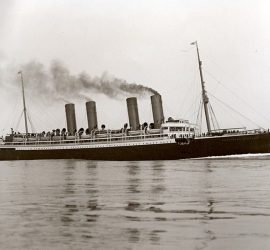1896 – 1922 / Also known as City of Honolulu / Notable for being the first German ship to exceed 10,000 gross tons, Friedrich der Grosse was seized by the Americans in World War I and used as a troop transport. She survived the war, but was destroyed by fire in 1922.
ndl
1897 – 1935 / Also known as Omar and Edison / Employed on the North Atlanic as well as the immigration run to Australia, Königin Luise was handed over to Great Britain after World War I. In 1935, she was sent to Italy for scrapping.
1897 – 1914 / Norddeutscher Lloyd’s Kaiser Wilhelm der Grosse was the ship that shook the British by snatching the Blue Riband into German hands for the first time. Serving as an armed merchant cruiser in The Great War, she was sunk in battle with the HMS Highflyer.
1898 – 1916 / Also known as Burdigala / Intended as another Norddeutscher Lloyd speed champion, the Kaiser Friedrich failed to meet requirements and languished for many years. She eventually found her place as a French ship on the South America run, but was sunk by a mine during World War I.
1901 – 1923 / A true German greyhound, the Kronprinz Wilhelm was one of the fastest ships of her time. Serving as an armed merchant cruiser in World War I, she spent eight successful months as a raider. Seized by the US in 1917, she served as a troopship and was sent to the breakers a few years after the armistice.
1903 – 1940 / The Kaiser Wilhelm II managed to set a new record for an eastbound crossing of the North Atlantic, but was interned in the US at the outbreak of World War I. Eventually seized and used as an allied troopship, the ship then languished for almost 20 years after the war, and was in the end sent to the breakers.
1907 – 1940 / The last of the German ‘Four Flyers’, the career of Kronprinzessin Cecilie ended when she was confiscated by the US for military use in World War I. Afterwards, she languished in Chesapeake Bay for almost 20 years before being scrapped.
1922 – 1936 / Also known as Columbus / Originally a German ship, her construction was interrupted by World War I. Handed over to White Star after the war and renamed Homeric, it took several more years to complete her. She then served as a British ship for a little more than a decade, before being sent to the breakers.
1925 – 1966 / Also known as Berlin / The first ship built for the Swedish-American Line, the Gripsholm was also the first motor ship on the North Atlantic run. She helped cement the company’s reputation on the high seas, but was eventually sold and enjoyed a second life as a German liner.










